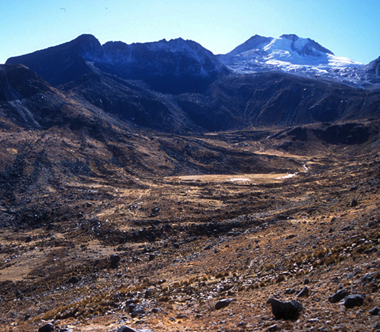Joint Study Unearths Link Between Industrialization, Melting of Tropical Glaciers
Rising air temperature, warming of tropical Pacific Ocean accelerating retreat according to Nature article
 |
|
A new study in Nature indicates a link between industrialization and the speed at which the Telata Glacier in Bolivia (above) is melting. |
ALBANY, N.Y. (June 29, 2011) -- A rise in air temperature of 3°C and the warming of the tropical Pacific Ocean are mainly linked to tropical glacial melt during the past 10,000 years -- a process that has accelerated with the onset of industrialization -- according to University at Albany Assistant Professor Mathias Vuille and a team of French researchers. The paper, which examines the retreat of the Telata glacier in Bolivia, is published in the June 9, 2011, issue of Nature.
The surface area of the glacier decreased, and its front retreated by 3 kilometers (km) since the start of the Holcene Period, or about 10,000 years ago. The glacial retreat has accelerated since the beginning of the 19th century, retreating by 2 km since 1820.
"Tropical glaciers are rapidly retreating throughout the tropics with severe consequences for future water resources," said Vuille. "Studies such as this one will help us to better understand how tropical glaciers respond to changes in temperature and precipitation patterns."
 |
|
Assistant Professor of Atmospheric and Environmental Sciences Mathias Vuille |
Telata, a high-altitude glacier, in the Cordillera Real range of Bolivia, provided the team with an ideal setting to conduct their research. The moraines (rocks deposited by the glacier, marking its earlier positions) from the Telata provide an almost unbroken record of successive glacial stages.
The moraines were dated by measuring the concentration of certain elements in the rocks, making it possible for the team to reconstruct the history of the glacier during the Holocene Epoch.
"Today Telata glacier has a total surface area of 0.137km2 -- or roughly the equivalent of about 25 football fields," said Vuille. "Eleven-thousand years ago the size was 1.79km2. Hence, the glacier has lost 92 percent of its surface area."
The study also confirms the exceptional nature of the rapid melting observed since the start of the "industrial revolution." Melting since 1820 is not linked to variations in insolation (exposure to radiation from the Sun) but to other mechanisms. This work shows the vulnerability of tropical glaciers, which are located at high altitude in an area where warming in the 21st century is predicted to be at its highest (4-5 °C in the Telata region).
![]() For more news, subscribe to UAlbany's RSS headline feeds
For more news, subscribe to UAlbany's RSS headline feeds
A comprehensive public research university, the University at Albany-SUNY offers more than 120 undergraduate majors and minors and 125 master's, doctoral and graduate certificate programs. UAlbany is a leader among all New York State colleges and universities in such diverse fields as atmospheric and environmental sciences, business, education, public health,health sciences, criminal justice, emergency preparedness, engineering and applied sciences, informatics, public administration, social welfare and sociology, taught by an extensive roster of faculty experts. It also offers expanded academic and research opportunities for students through an affiliation with Albany Law School. With a curriculum enhanced by 600 study-abroad opportunities, UAlbany launches great careers.


